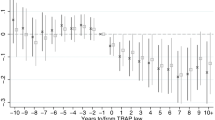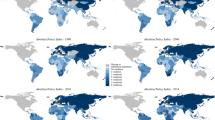Abstract
The purpose of the present study is to determine if laws requiring ultrasounds prior to an abortion being performed have any effect on the demand for abortions. Using state-level data, a synthetic control model (SCM) and a fixed effects model, results of the present study suggest that ultrasound laws have no statistically-significant effects on state-level abortion rates. In the SCM analysis, 21 states were in the treatment group (state had enacted an ultrasound law) and 22 states were in the potential control group. Results also suggest that states with lower per capita incomes, more non-Whites, and more abortion providers had higher abortion rates. This study is important because it is the first to use an SCM analysis to examine the effects of any type of restrictive abortion law on the demand for abortions.
Similar content being viewed by others
References
Abadie, A., & Gardeazabal, J. (2003). The economic costs of conflict: A case study of the Basque Country. The American Economic Review, 93(1), 113–132.
Abadie, A., Diamond, A., & Hainmueller, J. (2010). Synthetic control methods for comparative case studies: Estimating the effect of California’s tobacco control program. Journal of the American Statistical Association, 105(490), 493–505.
Abadie, A., Diamond, A., & Hainmueller, J. (2011). Synth: An R package for synthetic control methods in comparative case studies. Journal of Statistical Software, 42(13), 1–17.
Abadie, A., Diamond, A., & Hainmueller, J. (2015). Comparative politics and the synthetic control method. American Journal of Political Science, 59(2), 495–510.
Berger, M. (2004). National laws and unsafe abortion: The parameters of change. Reproductive Health Matters, 12, 1–8.
Bitler, M., & Zavodny, M. (2001). The effect of abortion restrictions on the timing of abortions. Journal of Health Economics, 20, 1011–1032.
Brown, R., & Jewell, R. T. (1996). The impact of provider availability on abortion demand. Contemporary Economic Policy, 14(2), 95–106.
Brown, R., Jewell, R. T., & Rous, J. (2001). Provider availability, race, and abortion demand. Southern Economic Journal, 67(3), 656–671.
Cameron, C., Gelbach, J., & Miller, D. (2008). Bootstrap-based improvements for inference with clustered errors. The Review of Economics and Statistics, 90(3), 414–427.
Centers for Disease Control and Prevention. (1990-2014), Abortion Surveillance, https://www.cdc.gov/reproductivehealth/Data_Stats/Abortion.htm.
Contrada, A. (2002). “Saving more babies with ultrasound, Massachusetts News, February 2002. https://web.archive.org/web/20030626145842/http://www.massnews.com:80/2002_editions/01_Jan/12302preg.htm.
Ellertson, C. (1997). Mandatory parental involvement in Minor’s abortions: Effects of the Laws in Minnesota, Missouri, and Indiana. American Journal of Public Health, 87(8), 1367–1374.
Garbacz, C. (1990). Abortion demand. Population Research and Policy Review, 9(2), 151–160.
Gatter, M., Kimport, K., Foster, D. G., Weitz, T., & Udadhyay, U. (2014). Relationship between ultrasound viewing and proceeding to abortion. Obstetrics & Gynecology, 123(1), 81–87.
Gerdts, C., Fuentes, L., Grossman, D., White, K., Keefe-Oates, B., Baum, S., Hopkins, K., Stolp, C., & Potter, J. (2016). Impact of clinic closures on women obtaining abortion services after implementation of a restrictive law in Texas. American Journal of Public Health, 106(5), 857–864.
Gius, M. P. (2007). The impact of provider availability and legal restrictions on the demand for abortions by young women. Social Science Journal, 44(3), 495–506.
Gius, M. (2011). The effect of ultrasound Laws on abortions: A state-level analysis. Journal of Applied Business and Economics, 12(5), 2011 http://www.na-businesspress.com/JABE/GiusM_Web12_5_.pdf.
Gober, P. (1994). Why abortion rates vary: A geographical examination of the supply of and demand for abortion Services in the United States in 1988. Annals of the Association of American Geographers, 84(2), 230–250.
Gohman, S., & Ohsfeldt, R. (1993). Effects of price and availability on abortion demand. Contemporary Policy Issues, 11(4), 457–475.
Grossman, D., Baum, S., Fuentes, L., White, K., Hopkins, K., Stevenson, A., & Potter, J. (2014). Change in abortion services after implementation of a restrictive law in Texas. Contraception, 90, 496–501.
Guttmacher Institute (2018). Induced abortion in the United States. https://www.guttmacher.org/fact-sheet/induced-abortion-united-states.
Haas-Wilson, D. (1996). The impact of state abortion restrictions on minor's demand for abortions. The Journal of Human Resources, 31(1), 140–158.
King, R., Myers, S., & Byrne, D. (1991). A note on the economic determinants of teenage abortion. Atlantic Economic Journal, 19(3), 70.
Kreif, N., Grieve, R., Hangartner, D., Turner, A. J., Nikolova, S., & Sutton, M. (2016). Examination of the synthetic control method for evaluating health policies with multiple treated units. Health Economics, 25, 1514–1528.
Leibowitz, A., Eisen, M., & Chow, W. (1986). An economic model of teenage pregnancy decision-making. Demography, 23(1), 67–77.
Matthews, S., Ribar, D., & Wilhelm, M. (1997). The effects of economic conditions and access to reproductive health services on state abortion rates and birthrates. Family Planning Perspectives, 29(2), 52–60.
Medoff, M. (2002). The determinants and impact of state abortion restrictions. American Journal of Economics and Sociology, 61(2), 481–493.
Meier, K., Haider-Markel, D., Stanislawski, A., & McFarlane, D. (1996). The impact of state-level restrictions on abortion. Demography, 33(3), 307–312.
Merz, J., Jackson, C., & Klerman, J. (1995). A review of abortion policy: Legality, Medicaid funding, and parental involvement, 1967-1994. Women’s Rights Law Reporter, 17(1), 1–61.
National Right to Life Committee. (1990-2014) https://www.nrlc.org/site/statelegislation/.
New, M. (2004). Analyzing the effects of state legislation on the incidence of abortion during the 1990s. Heritage Foundation Report https://www.lifeissues.org/pdf/Analyzing_Effects_of_Legislation.pdf.
New, M. (2011). Analyzing the effect of anti-abortion U.S. state legislation in the post-Casey era. State Politics & Policy Quarterly, 11(1), 28–47.
Powell-Griner, E., & Trent, K. (1987). Sociodemographic determinants of abortion in the United States. Demography, 24(4), 553–561.
Siddique, J., Lauderdale, D., VanderWeele, T., & Lantos, J. (2009). Trends in prenatal ultrasound use in the United States. Medical Care, 47(11), 1129–1135.
U.S. Census Bureau. (1990-2014). American Community Surveys, https://www.census.gov/programs-surveys/acs/data.html.
Author information
Authors and Affiliations
Corresponding author
Additional information
Publisher’s Note
Springer Nature remains neutral with regard to jurisdictional claims in published maps and institutional affiliations.
Electronic Supplementary Material
ESM 1
(DOCX 321 kb)
Rights and permissions
About this article
Cite this article
Gius, M. Using the Synthetic Control Method to Determine the Effect of Ultrasound Laws on State-Level Abortion Rates. Atl Econ J 47, 205–215 (2019). https://doi.org/10.1007/s11293-019-09619-4
Published:
Issue Date:
DOI: https://doi.org/10.1007/s11293-019-09619-4




